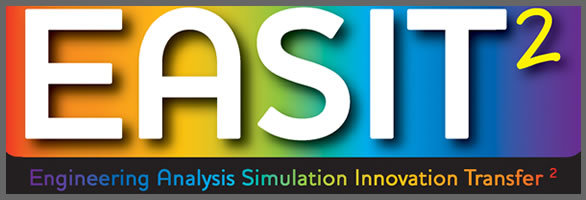EASIT2

NAFEMS was a major partner in the EASIT2 project – Engineering Analysis and Simulation Innovation Transfer (squared) European project.
The main aim of this Leonardo da Vinci European Transfer of Innovation project was to set out the knowledge and skills that a competent simulation engineer should possess. The goal was to transfer, modify and extend the output from the recently completed and highly successful CCOPPS project, which developed a similar framework for the pressure systems industry sector, and to make it applicable to a wide range of industry sectors.
There was three key deliverables from the project:
- An “Educational Base”. This is a set of detailed statements explaining what competencies a good simulation engineer should have. This was split down in to a number of different modules, covering different areas of technology (e.g. FEA fundamentals, dynamics, composites etc). It was also intention that links were provided to appropriate books and training courses that would help an engineer to gain the appropriate competence.
- A “Competency Framework”. This is a computerised system that allow the skills that are developed by individuals to be tracked and logged. This can then be used by individuals to plan and monitor their career development as a simulation engineer, or by companies to do the same for their staff and to keep a database of the combined simulation skills of their workforce.
- A revised and updated Registered Analyst Scheme, based upon the competency statements that have been established.
The project was managed by a strong EU-wide partnership headed up by the University of Strathclyde (leader of the CCOPPS project). The project manager was Dr. Jim Wood who, as a staunch supporter of NAFEMS for many years, shaped the proposal so that the outcomes would be of great benefit to all NAFEMS members. In addition to NAFEMS, the other project partners were AMEC Power & Process Europe, EADS Innovation Works, EnginSoft, E.ON, Geofem Ltd., Nevesbu, Nokia Corporation, RENAULT, SELEX Galileo and Tetra Pak Carton Ambient S.p.A., covering 9 key European industry sectors.
This project was extremely beneficial to NAFEMS. One of our key goals, and a major part of our mission, is to provide effective educational support for all its members. The project allowed us to be far more effective in achieving this. The benefit of enabling the existing Registered Analyst Scheme to be reviewed and updated is an added bonus.
The initial proposal was that the EASIT2 Generic Educational Base would cover the following areas (modules):
Finite Element Analysis
Computational Fluid Dynamics
Beams, Membranes, Plates and Shells
Mechanics, Elasticity and Strength of Materials
Fundamentals of Flow, Heat and Mass Transfer
Materials for Analysis and Simulation
Plasticity and Shakedown
Creep and Time-Dependency
Thermo-Mechanical Behaviour
Flaw Assessment
Fatigue
Optimisation
Dynamics and Vibration
Composite Structures
Buckling and Instability
Nonlinear Geometric Effects and Contact
Non-deterministic Analysis
Multi-Physics Analysis
This list may be modified as a result of an initial study of industry needs. Input from a wide range of experts drawn from the NAFEMS community was used to ensure that the various modules in the Generic Educational Base had the appropriate statements of competence and resource references.




